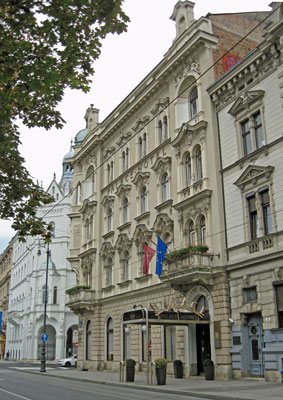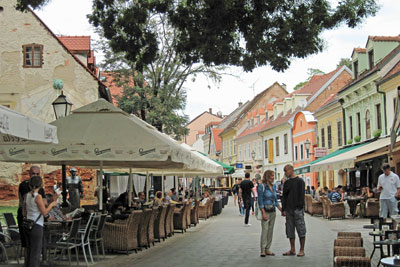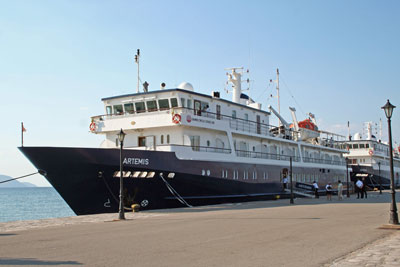Eating our way along the Dalmatian Coast
This article appears on page 18 of the March 2014 issue.
by Wanda Bahde; Summerfield, FL
Where can you travel, eat all the goodies you want and still not gain weight? Though it sounds like a fantasy, our August 2013 “Hidden Gems of the Dalmatian Coast & Greece” cruise-tour with Grand Circle Cruise Line (Boston, MA; 800/221-2610) fit that description.
The talented chef on the Artemis prepared expansive buffet breakfasts and lunches and multicourse gourmet dinners. Sidewalk cafés enticed us for ice cream and pastries, offering refuge from the scorching 90-plus-degree temperatures.
We sampled everything, including desserts three times a day, but still were able to work off the excess calories. My husband, Ray, and I explored every place time permitted. Twenty-five steps up or down was common, and 90 was not unusual! Plus our 3-story ship had no elevator.
Due to the steps, uneven surfaces and lots of walking, this proved to be among the more strenuous Grand Circle tours we’d ever taken.
Getting underway
Our group of 17 assembled in Athens, Greece, for a welcome dinner at the sixth-floor La Suite Lounge of the St. George Lycabettus Hotel. Although exhausted from our long transits, we marveled at the sunset over the Acropolis and watched lights twinkle on as we eagerly anticipated our forthcoming adventure.
Following a brief city tour with time to visit the impressive Acropolis Museum, we traveled to Mikrolimano, where we joined another Grand Circle group aboard the Artemis, a 50-passenger ship that would be our home for 10 nights.
Our cabin was spacious, with a large shower, a mini-fridge, a television and a microscopic balcony. Meals were delicious, the crew was attentive, and the lectures were informative.
We sailed through the Corinth Canal to Itea for a side trip to Delphi, explored Corfu’s Old Town and continued on to Albania, where we toured the UNESCO World Heritage Site of Butrint. (Warning — beware of mosquitoes in Butrint.)
More fascinating, to me, were the abandoned defense bunkers there. After WWII, more than 700,000 defense bunkers were built in Albania to fend off feared attacks from fellow Communists and the West. Many still remain.
In Saranda, while other group members stocked up on inexpensive Albanian brandy, Ray and I relaxed with ice cream bars and watched the frolicking beachgoers.
The ancient walled port city of Kotor, Montenegro, bustled with music, art, churches and sidewalk cafés. The city came alive at night, and its city walls, extending far up the mountainside, were brightly lit. Finally, we experienced the Mediterranean atmosphere we’d sought! But then it got better.
We relaxed at the Forza Café (Oružja Square) while sampling Moskva šnit, adapted from Belgrade’s Hotel Moscow recipe, for €3 ($4). This light, layered torte consisted of pineapple, sour cherries, almonds and whipped cream between layers of dense cake. To die for!
Dubrovnik
Sailing into Dubrovnik, Croatia, I eagerly anticipated walking its walls, a bucket-list goal of mine. The walled Old Town, rebuilt after being damaged by earthquakes and bomb assaults, proved more compact and touristy than I expected.
After a group walking tour, Ray and I climbed a mountain of steps near the Pile Gate to follow the 6,363-foot-long guards’ walkway counterclockwise around Old Town. Tickets cost 90 kuna ($16) each.
The walkway resembled the Great Wall of China but with prettier views. We watched crashing surf, kayakers and windsurfers, peered into pristine courtyards and bombed ruins and looked across red-tile roofs toward the cathedral domes and distant city walls.
Toilets and refreshment kiosks were scattered along the walkway. We cooled off with ice cream in a small shop inside the wall near the Mincˇeta Tower, but then a hailstorm rolled across the bay toward the city. Everyone, including us, scurried off the wall to safety.
In spite of the storm, walking the city walls was a trip highlight! Luckily, we reached Café Festival, on the Stradum near Pile Gate, just before hail pelted the city! During the storm, we enjoyed tuna sandwiches and sodas for 75 kuna ($14) each.
Unfortunately, our ship was docked in distant Gruz, so we weren’t able to experience Dubrovnik at night. Had time and weather permitted, we could have returned by public bus (numbers 1A, 1B and 1C travel between the Pile Gate and Gruz), but our stay was too brief.
On to Split
We toured the islands of Korčula and Havar, the latter known for its dry wall terraces and lavender, before reaching Split, our final port.
Split, Croatia’s second-largest city, is an interregional hub for boats linking the Adriatic islands to the mainland. The Artemis docked adjacent to the ferries and within a 10-minute walk of the town center. We found ferry-watching fascinating.
Our walking tour began at Diocletian’s Palace. In AD 284 the Roman emperor built this retirement palace, which resembled a military fortress and supported 8,000 people. After the fall of the Western Roman Empire, this abandoned structure was recycled into homes for refugees and newcomers.
Today, 80% of the homes are privately owned, we were told. Although the exterior walls may not be altered, the interiors are impressive, judging by realtor photos. The average cost for a 1,000-square-foot apartment was $150,000.
Outside the palace we wandered the narrow streets, passing historic architecture and bustling activity. We found fish and fresh produce markets and modern shops.
We relished tangy lemon ice cream, complete with chunky zest, at Caffe Bar-Pivnica Plac (People’s Square, Narodni Trg 12). Our guide had teased earlier, “Why pay four kuna (70¢) to use a public toilet when you can get ice cream, a glass of water, a place to rest and a clean toilet for only eight kuna?”
He didn’t even mention the people- watching! We returned twice.
Inland to Zagreb
After bidding farewell to the crew of the Artemis, we traveled inland by bus. Near Slunj, we crossed the front lines where, in the 1990s, Serbs and Croats battled for control of Zagreb, Croatia’s capital. Bombed buildings and undiscovered land mines in the fields remain.
Our Zagreb home for three nights was the comfortable Palace Hotel, a renovated private palace featuring Old World ambiance, a convenient location and extensive buffet breakfasts. Although trams 6 and 13 passed the hotel, we walked everywhere.
Only a few blocks away we found Pizzeria Lira (Nikole Tesle 5), where we shared a small pizza topped with tomato, cheese, ham, mushroom, smoked bacon and chili pepper for 29 kuna ($5). The congenial waiter and light fare were perfect after the long bus trip.
We ended the evening with a cappuccino for eleven kuna and ice cream for eight at Millennium (Bogovićeva 7), a stylish outdoor café.
Because August 15th was Assumption Day, a national holiday, the city was nearly deserted during our walking tour. Even the Dolac farmers’ market was closed.
The highlight was the Croatian Museum of Naïve Art (Gornji Grad), where we were introduced to naive art and Croatian reverse glass painting. Unlike traditional artists who first paint the background on canvas, then add detail, these Croatian artists first paint the detail on glass and then continue, layer by layer, adding the background.
After leaving Zagreb’s Gornji Grad, or Upper Town, through the Stone Gate chapel, we noticed a huge painted egg with scenes representing different seasons. This naive artwork enticed us into the Mirko Virius Gallery (Tkalčićeva 14), operated by the Croatian Association of Naïve Artists. The proprietor artist even demonstrated reverse glass painting for us. Unfortunately, our favorite painting, at $1,000-plus, remains at the gallery.
Our final evening in Zagreb was perfect! We joined the parade of people strolling Tkalčićeva Street, the lively pedestrian street filled with street musicians, restaurants and bars.
Later, in Strossmayer Park Gazebo, located across from our hotel, we discovered a Croatian band performing rock-and-roll classics in English, including a striking rendition of Pink Floyd’s “The Wall,” while everyone, including us, danced. I didn’t want to leave Zagreb!
On to Slovenia
Only six tour members continued on the post-trip to Slovenia’s resort town of Bled. The well-located Hotel Kompas Bled, perched on a hillside adjacent to downtown, became home for our final three nights. (Hint — ask for a room facing Bled Castle on an upper, even-numbered floor.)
That evening we dined on the terrace of Ostarija Pegležn (Cesta Svobode 19a). Their special of grilled sole, mixed vegetables, Mediterranean potatoes and salad (€18, or $24) was tasty and the service, welcoming. Watching the sun set over distant Bled Castle enhanced the experience.
The Bled cream cake (€3.40) at Kavarna Park, located on the lake opposite Hotel Park), capped the evening. In 1953, Hotel Park pastry chef Ištvan Lukačević created this specialty by adapting an old Serbian recipe. His adaptation consisted of light puff-pastry dough layered with egg-based cream, whipped cream and powdered sugar. We returned every evening.
Daily excursions included Bled Island, Bohinj in the Julian Alps and Bled Castle.
Most impressive was an optional tour to Postojna ($85 per person). At the unusual Predjama Castle, built into an enormous cave outside of town, we heard stories about its most famous resident, Erazem, a 1480s “Robin Hood.” Then we rode a train deep into the Postojna Cave system to explore stalagmites, stalactites and limestone formations along a footpath. Note: Take a coat.
On our final evening, our cohesive group joined the mix of local residents and travelers in the patio garden of Gostilna Union (Hotel Union, Ljubljanska 9), which featured both traditional and grilled cuisine. My grilled trout and Ray’s sirloin, plus our shared salad (€36 total), were tasty and well presented. Of course, afterward, we returned to Kavarna for cream cake!
Practical matters
Our trip cost $18,463, including $12,517 to Grand Circle for the cruise-tour and the extension plus fees; $3,446 for airfare from Orlando to Athens and from Ljubljana to Orlando; $1,120 for Travel Guard insurance; $740 in tips, and $640 for food and miscellaneous purchases. Note: When flying out of Zagreb, any batteries must be placed in your carry-on luggage, not your checked luggage.
We changed money at banks using photocopies of our passports, since the ship held our originals. ATMs were available in most cities.
In Croatia, the kuna was the required currency. Elsewhere, except in Albania (where they use the lek), euros were preferred. Most restaurants accepted credit cards.
The ship accepted credit cards for tips and incidentals but could not change money. Most of our cash was used for tipping the one or two step-on guides per day.
Tap water was safe to drink everywhere, including on our ship, unless otherwise posted.
We felt the tour schedule restricted our exploration time, and we wished for larger blocks of free time, especially in Dubrovnik, Split and Zagreb. Instead, we relished the brief opportunities we had to absorb local atmosphere in sidewalk cafés.
And with all the walking and steps, we didn’t even gain weight!





